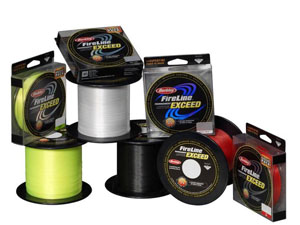
Choose your Line
This is how you choose the right braided line
One of the most important parts of your material is the line. With this you can actually reel in the fish and you have contact with the fish. It should therefore be clear that fishing with the right line is of great importance. In this article we explain how you can make an informed choice between all braided lines so that you are sure that you are fishing with the right one.
There are many different types of braided line… but which one is best for your situation?
Braided line
Before we go deeper into how you can make a choice between all braided lines, we would first like to explain why you should go for a braided line.... or not. Because a braided line is not necessarily better than a nylon line. A braided line has the great advantage that it is much stronger than a nylon line, so you can fish with a thinner diameter. In addition, a braided line has no stretch, so you can feel bites much better. But the lack of stretch or damping can also be a disadvantage when you have to properly drill the fish.
In short, consider carefully whether the fact that there is no stretch in the line is an advantage or a disadvantage. When feeder fishing at long range it can be an advantage, because you hit with the tip. A braided line is also an absolute advantage when fishing with lures for predatory fish, because you can feel even the smallest bites. But if you go carp fishing with a self-hook system, where the carp hooks itself on the weight of the lead, then the advantage is suddenly a lot less. Because carp is a strong fish, the damping in the line is nice.
Unfortunately, braided line also has a major disadvantage, namely that it is much less resistant to abrasion than nylon line. This makes it inadvisable to fish with a braided line in water with many obstacles. So far the main differences between nylon line and braided line. However, there is much more to say about it, so if you want to know even more, read our article that further discusses the differences between nylon line and braided line. In this article we now assume that braided line is the best choice for your situation.
Types of braided line
If you look at the braided lines category page on our site, you will see that the choice is still very large. Not only are there many different models, but even a model has countless variants in diameter. First, let's talk about the different models. A braided line is woven from several thinner lines that together form one whole. This is done with a minimum of 4 strands, up to about 12 strands. The more strands used in weaving, the smoother the line. Is more than always better? Yes and no. A smoother line means that you can cast further and that the line has less effect on, for example, the lure you are fishing with. But a braided line woven from 12 strands is significantly more expensive than a line woven from 4 strands. If you are going to fish in a way where the flexibility of the line can play a role, such as ultra light fishing or trout fishing, we recommend a braided line that is woven from 8 strands such as the Spiderwire Stealth Smooth 8 or even one that is woven is made of 12 strands such as Spiderwire Smooth 12. However, if you go pike fishing with deadbaits, in water with little current, a cheaper line of 4 strands such as the Spiderwire Stealth Dura 4 or a 5-carrier (5 strands) such as the Berkley X5 will also suffice fine.
The number of strands from which a line is woven is not always clearly indicated by the manufacturer, but often a number between 4 and 12 can be found in the name or packaging.
Braided line with coating
In addition to the number of strands, some lines also have a finish in the form of a coating. The Spiderwire Stealth Smooth 8 series, for example, has a certain teflon coating over the line, which makes the line much smoother than the Spiderwire Dura 4, which does not have this. This also ensures that you can cast further. Basically you can say that if money is no object, a line that is woven from more strands is always preferable to a braided line that is woven from fewer strands.
In addition to a coating to make the line smoother, another coating is sometimes also applied. Every braided line has the property to float, but that is not always desirable. In some fisheries it is desirable that the line does not float, but sinks. Braided lines that sink have also been developed especially for those cases. These are mainly used for feeder fishing and carp fishing. Examples include the Preston Absolute Feeder Braid and the Pole Position Slackliner Sinki.